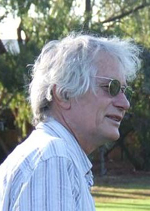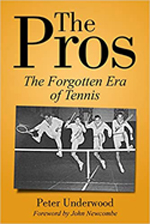The First Slam
Peter Underwood

At 21 years of age, Rod Laver first got through to the final rounds of a major—the 1959 Wimbledon. In the Final, he found himself confronting the Peruvian American Alex Olmedo.
Olmedo was strong, possessed a fine serve and volley, but was neither very quick nor very strong off the ground, particularly on the backhand. Laver possessed an all court game, and understood exactly what to do to exploit his opponent's weaknesses. But he lost in straight sets.
Back home, his coach Charlie Hollis was furious. He knew that Laver had not only got through the draw to reach the Final of the Men's Singles, but he'd managed the same in both the Men's and the Mixed Doubles.
Officials informed Rod that he had played over 600 games, many in the five days before the Singles Final. It might have been a Wimbledon record, but it had it taken the edge off his game.
If this had taught Rod the necessity of focus, at first the results didn't show it. When the young man returned home in 1959, he contested another four significant singles finals, and lost the lot. To most observers, the flashy left hander was beginning to look like the perennial bridesmaid.

First Major
Despite this, the next year started so well that it seemed the doubters were wrong. To win his first major, the Australian Championships, Laver finally got past another left hander in Neale Fraser.
But he only just made it. To defeat the man, who up to then had often been his nemesis, required a Houdini act: surviving the loss of the first two sets and a match point against him.
But after this victory, the bridesmaid returned. In the 1960 Wimbledon Final, it was Fraser again. This time the Victorian won through in four tough sets.
Then the same Fraser repeated the dose in the Final of the US Championships. Fraser had a vicious serve, a great looping forehand, tricky volleys and a pokey little backhand --the epitome of left-handers who had served as a reverse model to Hollis.
A truly elite player would have exploited the flaws in Fraser's game, but Laver had not yet arrived among that elite. Nor was Laver setting the world alight when he squeezed his way onto the Davis Cup team. In 1959 he had played his first Challenge Round matches against the US--and lost both his singles matches.
Despite appearances, over these two years Laver was steadily learning to harness his power and spin sufficiently to reduce the lapses. Further, this diffident product of the Deep North had come to recognize another of his crucial deficiencies: the lack of killer instinct.

He realized that true champions, once they've found a weakness in their opponents, get them down, and keep them down. Off the court he was also maturing. His fellow, fun-loving Aussies found that their shy mate was becoming more outgoing, both within their group and in public.
This confidence was immediately apparent when the Wimbledon of 1961 came along. Rod played superbly throughout, and ended up with his first Wimbledon, and his second major title. While he didn't add any other big trophies that year, he forgave himself, because he knew that he'd been held back by a series of minor but debilitating injuries.
1962
Finally, by the beginning of 1962, he felt ready. Laver has admitted that as soon as he climbed near the top of the amateur tree he began to form a secret ambition: to win the famous Grand Slam.
The term was popularized by the only Slam winner, Budge himself. Budge's object to win the four major championships of Australia, France, Great Britain and the US in the one calendar year. He chose these countries because they were the only nations that, by 1938, had won the Davis Cup.
After Budge took the Slam he turned pro, and was of course banned from the great national championships. Almost 20 years later in 1956, another great Australian, Lew Hoad 1956 got to within a match of winning the Slam --there to be thwarted by an inspired Ken Rosewall.
Let's take a look at Laver's attempt in 1962 to emulate Budge's unique triumph a quarter of a century earlier. The first leg was the Australian Championship in January. Except for Roy Emerson - highly experienced, dead tough and at his peak - the draw seemed to offer Laver few problems. By cruising through to the Final, then beating Emerson decisively, Laver demonstrated that he was still improving and was by then more than a shade above the rest.

However, in the next leg of the Slam, the French Championship, arduously slugged out on the slow clay of Roland Garros, he struggled. Despite his apprenticeship on anthills courts, Laver admits that up to then he hadn't mastered slow courts.
After some significant early scares, in the quarterfinals he found himself up against the tough scrambler Martin Mulligan, and a match point down on his own second serve. But, defiantly, he served to Mulligan's stronger backhand. Swiftly following in, he brilliantly anticipated the down the line return, and smacked a backhand volley for a clean winner.
At this point the Laver self-belief caught alight. After dispatching Mulligan, in the semis he faced his old enemy--Fraser. The match reached the fifth set, but Rod now had joined the elite who could handle top left-handers, and was unstoppable.
The Final, against his old Queensland mate Emerson, also went to the wire. Yet against one of the fastest and fittest athletes in tennis, Rod galloped away with the fifth set 6-2 for the Championship and the second leg of the Slam.
This hard won victory consolidated one of Laver's deepest beliefs. The highly experienced Fraser had, in the crunch, played safe against him—and lost. Against Mulligan, at match point, The Rocket had gone for it--and won. Laver thought never in the future would he lose by "scratching around."

Despite all this, Laver allowed that the Slam's next leg, Wimbledon, made him "very nervous." Yet, after a bit of a scare in the form of the gifted Spaniard Manuel Santana in the quarters, by the time Laver reached the Final he was in ruthless form. On fast grass, he dispatched Mulligan in less than an hour.
Budge and Laver
Now only the US remained. According to Laver's own account, as he headed off for New York he tried to dismiss any thought of taking out the Slam. But the media was hooked on Budge's invention, and every day they were after him.
Then came a fortuitous intervention. For the first time, Laver managed a chat with none other than the only holder of the Grand Slam.
Up stepped J. Donald Budge, portly, worldly and kind. Finding a shy young man caught up in a media frenzy, on a whim Budge whisked him out of New York and into the cool of the Catskill Mountains.
There they relaxed, talked, and played a couple of "nonchalant" sets. Of these, the 46-year-old Budge took the second from the world amateur Champion.
But true modesty is a beautiful thing. In Don Budge: A Tennis Memoir, Budge mentions playing the sets, but not the result. Laver, in The Education of a Tennis Player, cites the loss of a set, and makes a point of saying how this showed what a marvel Budge was. By the time they were to return, the old master's words to Laver were few: all he had to do was play his own way.

This is what Rod did. Nevertheless, the Final against Emerson provided the worst jitters of his tennis life. In the middle of the match he so lost his legendary cool that his "racket felt foreign" to him--indeed so foreign that at one crucial instant he "held it wrong and hit a volley straight into the ground." But at once this elementary error seemed so comical to this unpretentious master that he started laughing, and this "broke the tension."
When he'd stopped laughing he held the racket correctly, and once more beat Emerson to take the US Championships in four tough sets. Afterwards, he said he retained almost no memory of the last minutes of the match and its immediate aftermath. Thus in 1962, after a quarter of a century Rodney George Laver joined John Donald Budge as the only winners of the Grand Slam. At the year's end he had also helped his country retain the Davis Cup, winning both singles. He was 24 years old, and indisputably the best player in the amateur world.





